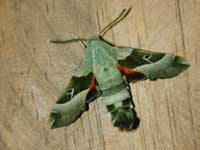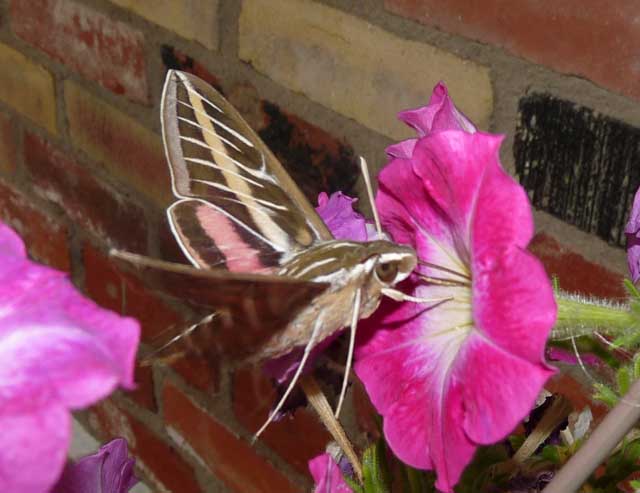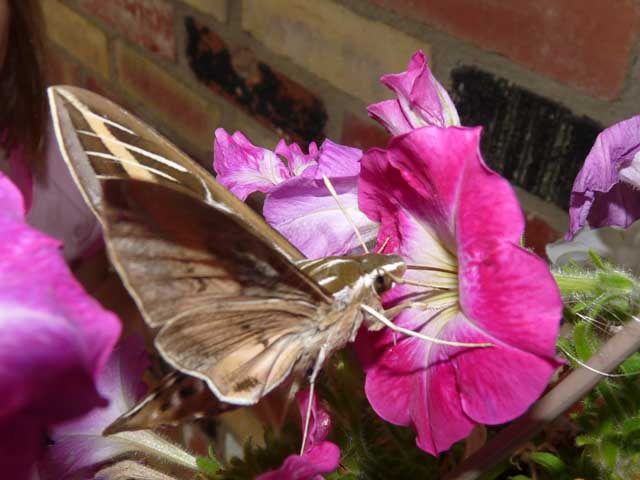Sphinginae subfamily
Sphingini Tribe:
 |
Ceratomia amyntor WO: Elm Sphinx, Four-horned Sphinx:
Fw: brown with dark brown, white markings including white costal area near wing base,
dark streaks along veins, white spot in cell. Hw: light brown; dark brown band along outer margin.
Elm (Ulmus), birch (Betula), basswood (Tilia), cherry (Prunus). |
 |
Ceratomia undulosa WO, Waved Sphinx:
Fw: pale brownish gray with wavy black, white line, black-outlined white cell spot.
Hw: gray with diffuse darker bands.
|
 |
Manduca quinquemaculatus WO, Five-spotted Hawkmoth:
Flies in tobacco fields and vegetable gardens (potatoes, tomatoes) and wherever host plants are found.
|
 |
Manduca sexta WO, Carolina Sphinx:
If you grow tomatoes, you have probably encountered Manduca sexta in the larval stage.Larvae get very large and can strip a tomato plant.
|
 |
Sphinx chersis
WO, Northern Ash Sphinx, Great Ash Sphinx
Fw: soft dark gray to blue-gray
with a series of black dashes, one of which reaches the wing tip.
|
 |
Sphinx drupiferarum
WO, Wild Cherry Sphinx:
The costal area in the basal and median areas of the forewing is light grey. This colour also
appears in the terminal area. The rest of the wing is dark slatey grey.
|
 |
Sphinx luscitiosa
WO, Canadian Sphinx, Clemen's Sphinx:
Fw: yellowish gray in males and pale gray with faint yellow tint in females. In both sexes,
dark border on outer margin widens as it approaches inner margin.
Hw: deep yellow in males, pale yellow in females; both with wide black border.
|
 |
Sphinx vashti
WO/BAMONA, Snowberry Sphinx:
Fw: narrow black subterminal line
bordered by a white inverted V-shaped line on the outside, and a
black line running inwards from the apex of the wing.
It is most often found in montane woodlands and along streamcourses. |
Smerinthini Tribe:
 |
Pachysphinx modesta
WO/BAMONA Modest Sphinx, Poplar Sphinx:
Fw: grey brown with diffuse lines.
The hindwing is bergundy with dark blue to black markings near the anal angle.
|
 |
Pachysphinx occidentalis WO, Big Poplar Sphinx:
This one is quite similar to Pachysphinx modesta, with modesta
being smaller and darker. Forewing lines are more distinct in P. occidentalis as compared
to P. modesta. There may be naturally occuring hybrids in Laramie.
|
 |
Paonias excaecata
WO, Blinded Sphinx: Grey-blue eyespot of hindwing gives this species its name. Birches, willows, cherries, oaks.
Outer edge of forewings is quite scalloped. |
 |
Paonias myops
WO/BAMONA, Small-eyed Sphinx:
Widespread and common and is likely present. This species ranges across North America.
The hindwings have a small blue eyespot ringed with black on a yellow background.
|
 |
Smerinthus cerisyi
WO/BAMONA, Cerisyi's Sphinx:
If you have willows and poplars nearby, you've probably got populations of
the Cerisyi's Sphinx. The hindwings are quite striking.
|
 |
Smerinthus jamaicensis
WO/BAMONA, Twin-spotted Sphinx:
Complete light coloured "C" shape, outwardly filled with dark brown, near right forewing apex.
S. cerisyi: lower reaches of light coloured marking does not return to outer margin.
|
Macroglossinae subfamily
Dilophonotini Tribe
 |
Hemaris thysbe
WO, Hummingbird Clearwing:
It is not difficult to see why many gardeners would mistake an Hemaris thysbe moth for a small hummingbird as it hovers,
sipping nectar from flowers through a long feeding tube.
|
 |
Hemaris diffinis
WO, Snowberry Clearwing or Bumblebee Moth:
This moth is widespread and is present at least in the northeastern part of Wyoming. It may fly throughout the state.
|
Dilophonotini Tribe
 |
Eumorpha achemon WO, Achemon Sphinx:
Fw: light grey and brown with many lines, dark patches near middle of the inner margin, near the apex and near the anal angle.
The entire basal area of the hindwing is pink.
|
Macroglossini Tribe
 |
Amphion floridensis
WO, Nessus Sphinix:
This day flier is widely distributed. If you have Virginia Creeper,
you probably have the Nessus Sphinx. Two bright, distinct, narrow
yellow bands are often visible on the abdomen.
|
 |
Darapsa myron
WO, Virginia Creeper Sphinx, Grapevine Sphinx:
Fw: dark brown to pale yellowish gray, with olive tint, often more green than described.
Costal margin with dark rectangular patch, may be reduced or absent. Hw: pale orange.
|
 |
Hyles gallii WO, Bedstraw Hawk Moth, Gallium Sphinx:
Fw: dark brown with slightly irregular cream-coloured transverse line. The outer margin is grey. There is bright pink band on hindwing.
|
 |
Hyles lineata
BAMONA, the White-lined Sphinx:
This species is very widespread. It can be seen flying during the day,
into the evening and also at night.
The highly variable larvae are often found in people's gardens. |
 |
Proserpinus juanita
WO, Juanita Sphinx:
The upperside of the forewing is pale gray-green with a deep
green-brown median area and a white dash at the wing tip.
|
|
|



